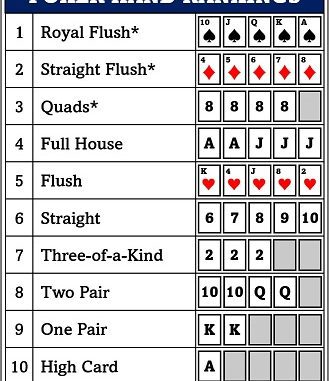
Poker Cheat Sheet for Beginners Free
A poker cheat sheet can be a handy tool to improve your game! Here are some key elements typically included in a poker cheat sheet:
- Poker Hand Rankings: A quick reference to the strength of different poker hands, from Royal Flush to High Card.
- Starting Hands: Guidelines on which hands to play from early position, middle position, and late position.
- Position Cheat Sheet: Tips on how to play based on your position at the table.
- Poker Lingo: Common poker terms and phrases to help you understand the game better.
- Betting Strategies: Basic strategies for betting, raising, and folding.
- Post-Flop Play: Tips on how to play after the flop, including continuation bets and check-raises.
- Poker Odds: Basic odds and outs to help you make better decisions.
Here’s a breakdown of the essentials in a cheat sheet format, combining key elements for beginners and those looking for a quick refresher:
1. Poker Hand Rankings (Best to Worst)
- Royal Flush: A, K, Q, J, 10 of the same suit.
- Straight Flush: Five cards in sequence, all of the same suit.
- Four of a Kind: Four cards of the same rank.
- Full House: Three of a kind and a pair.
- Flush: Five cards of the same suit (not in sequence).
- Straight: Five cards in sequence (not of the same suit).
- Three of a Kind: Three cards of the same rank.
- Two Pair: Two different pairs.
- One Pair: Two cards of the same rank.
- High Card: If no one has a pair or better, the highest ranking card wins.
2. Basic Poker Actions
- Fold: Discard your hand and forfeit any chips you’ve already bet.
- Check: Pass the action to the next player without betting (only if no one else has bet).
- Bet: Place chips into the pot.
- Call: Match the current bet.
- Raise: Increase the current bet.
3. Position is Key
- Early Position: Players who act first after the blinds. They have less information.
- Middle Position: Players in the middle of the action.
- Late Position: Players who act last. They have the most information and can be more aggressive.
- The Button: The dealer position, considered the best position in poker.
4. Starting Hands
- Premium Hands (Play aggressively): AA, KK, QQ, AK
- Strong Hands (Play most of the time): JJ, TT, 99, AQ, AJ, KQ
- Speculative Hands (Play cautiously, often for draws): Suited connectors (like 78s), small pairs
- Weak Hands (Usually fold): Offsuit, uncoordinated hands
5. Reading the Board
- Community Cards: The cards dealt face-up in the center of the table.
- Draws: Hands that need more cards to improve (e.g., flush draw, straight draw).
- Pot Odds: The ratio of the current bet to the size of the pot (helps you decide if a call is worthwhile).
6. Basic Strategy Tips
- Play tight early: Be selective with your starting hands, especially in early position.
- Be aggressive with strong hands: Bet and raise to build the pot.
- Pay attention to your opponents: Observe their betting patterns and try to read their hands.
- Manage your bankroll: Don’t bet more than you can afford to lose.
Where to Find More:
- Printable Cheat Sheets: Many websites offer printable poker hand ranking charts and basic strategy guides.
- Online Resources: Websites like PokerNews.com and 888poker.com have excellent articles and tutorials.
- Books: There are countless books on poker strategy for all levels.
Remember, poker is a game of skill and strategy. The more you play and learn, the better you’ll become!